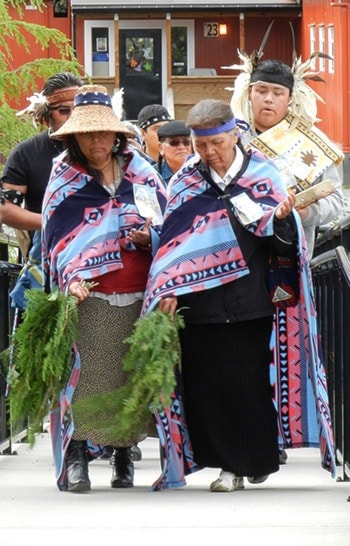The sun broke through the clouds briefly Friday as the silver Dodge Caravan pulled into parking lot of the Sto:lo Resource Centre. It had just completed the long journey from the University of British Columbia.
But the cargo it carried – 11 cedar boxes of varying sizes – had been on an even longer journey.
The boxes contained the fragmented remains of 11 Sto:lo ancestors, being returned to Sto:lo territory as part of a collaborative effort by the University of British Columbia Laboratory of Archaeology (LOA), Sto:lo Nation, Sto:lo Tribal Council, Coqualeetza Cultural Education Centre, and Sts’ailes First Nation.
The ancestral remains had been in the care of UBC since the 1950s. Getting them back home has taken nearly six years, and the journey isn’t over yet.
“It was more important for us to do this right than to do this quickly,” said Ch’iyaqtel First Nation-member Herb Joe, a member of the Sto:lo committee.
Discussions between UBC and Sto:lo representatives began in 2006 when Dr. Sue Rowley, current director of LOA, asked Sto:lo representatives if their communities had an interest in the return of ancestral remains which had ended up in LOA’s care.
Follow-up planning involved the collective effort and input of multiple Sto:lo First Nations. The Sto:lo House of Respect Care-taking Committee, a group of Sto:lo elders, cultural advisors and staff, formed to facilitate repatriation cases and issues on behalf of the Sto:lo community, played a lead role.
Said committee-member Chief Frank Malloway of Yakweakwioose First Nation: “It’s important that we take care of our ancestors ourselves, at home in our own community.”
The complex, collective process leading to the repatriation considered numerous issues including a broad-range of community-based and scientific concerns, interests, questions and protocols.
A key question common to the Sto:lo community and LOA scientists alike was one of identity. Through collaboration, questions of the ancestors’ identities as individuals have begun to be addressed. An important basis of Sto:lo protocol dealing with deceased ancestors is knowing who they are and as much about their history as possible, as members of their community – including their sex, age, health, diet, child-bearing status if female, and how long ago they lived. Numerous experts at LOA offered scientific options for answering these questions, such as physical analysis, isotopic analysis, and radiocarbon dating. All aspects of analysis were governed by the Sto:lo Committee.
One of the protocols established by the Committee was that the ancestors needed to be returned home before any techniques that require the removal of small samples, such as C14 dating, could be applied. Non-destructive analyses applied to date have effectively begun to develop biographies of each individual.
This information is proving to be critical in informing the next major step of the Journey Home Project, deciding culturally appropriate processes and protocols that will finally bringing these ancestors’ long journey to an end, in the care and disposition of the community.
On Friday, Sto:lo songs and a solemn procession marked an important part of the Journey Home with the physical return of the ancestors’ remains. Before the celebration, each ancestor was placed into a custom-made cedar box, and then brought to the Sto:lo Resource Centre. The Centre, itself a collaborative Sto:lo project, was constructed and opened in 2010 in part to provide facilities in support of such community needs. Following traditional practices, a small cedar plankhouse, built by Skowkale First Nation-member Jeff Point, was assembled in the Centre’s Cultural Repository as the place where the ancestors will be temporarily housed. Additional scientific analyses, continuing to be overseen by the Sto:lo Committee, will be carried out following their return home. Biographies of each of the eleven individuals and a set of community guidelines for the treatment of ancestral human remains are planned to be produced as outcomes of the collaboration between LOA and the Sto:lo Committee. After the gathering on Friday, planning will continue for the final steps of the Journey Home.
